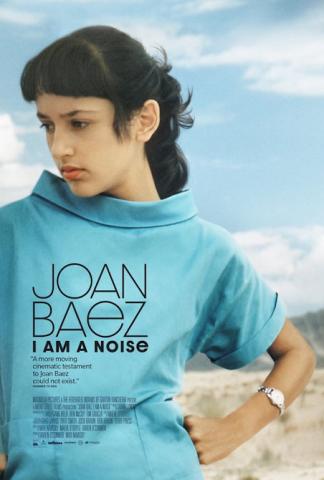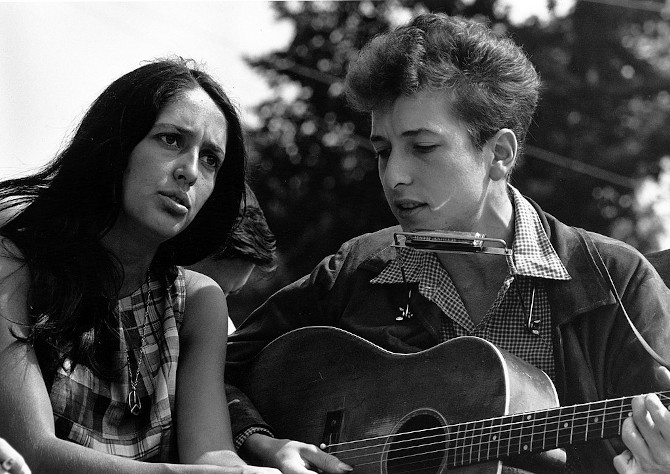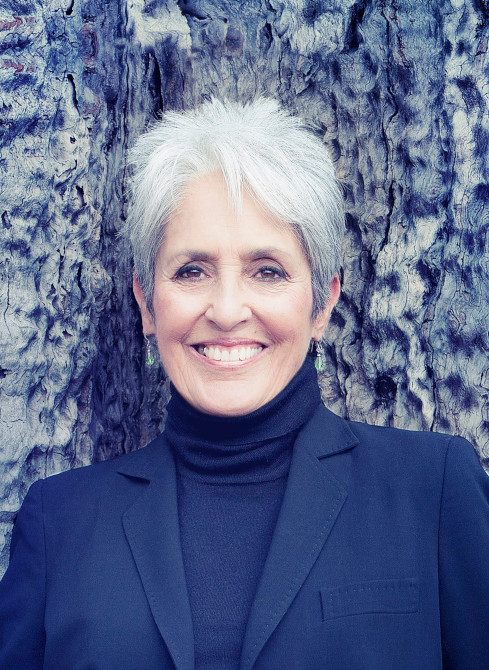Joan Baez: 60 Years of Sound and Still Counting

Joan Baez made a noise—a big one. Still shy of 20, when this legendary folk singer and protest activist adorned the cover of Time magazine, she could hit the purest notes anyone had ever heard or could remember. And we all know early stardom can be the harbinger of a shaky destiny. That veritable candle can burn at both ends, but it will not last the night.
For Baez, now 82, the good news is that for over 60 years of performing, she outlasted that long night, coming out the other side to see another morning of an extraordinary life. That’s not only good fortune for her, but for Mira Navasky, Karen O’Connor, and Maeve O’Boyle, the directors of I Am a Noise. Through a rich pastiche of the singer’s own confessional narration; archival footage of the last half of the 20th century; interlaced with animation of Baez’s own drawings and performance clips—even the hypnotic, somnambulistic voice on tape of her own therapist — their film stands as one of the frankest stories of fame to be seen.
If this up-close and personal account veers dangerously close to a saga of obsessive navel gazing, it is saved by the treasure trove of memorabilia Baez has lent to the proceedings. A very young Joan is seen flirting and pouting her way through the California landscape her Mexican-American father chose to document. Roughhousing with her two sisters, bellowing out early tunes on her guitar, sketching and journal writing with a rare and prescient talent—it’s all here. As a research scientist in physics, the senior Baez exposed his family to parts of the world like Baghdad, where a social consciousness blossomed in the girls at an early age. It was there, according to Joan, before the voice developed.

This early raw talent was generously spread among the three sisters. Sister Mimi is seen performing songs with husband Richard Farina. Tragically, the promising future for this duo was cut short by Farina’s early death in a motorcycle accident. One of their more popular songs, “Pack Up Your Sorrows,” was written by the third sister, Pauline.
When celebrity came -- Baez still kicking her mercurial self out of adolescent angst — it didn’t just knock but blew the door wide open. She confesses that at a certain point, trying to find her young self in this morass of public adulation, she thought herself to be the Virgin Mary reincarnated. Touring with the Farinas; falling into a lesbian relationship then out again; finding a soulmate in the unknown Bob Dylan and encouraging this gargantuan talent until his own fame broke open and he “broke my heart,” the viewer is shuttled into a tailspin of the times.
It was no surprise that an impressionable girl, raised by Quaker parents, became an unremitting activist. She met and married the dashing antiwar protestor David Harris, and for a few years, she sang to her legions while he spoke. “We Shall Overcome” became the mantra for a generation of peaceniks, but for Baez, their marriage couldn’t overcome the fact that he was several years younger, and she was “crazy.” Looking back, Baez makes an astute revelation: “I’m not very great at one relationship, but I’m great at 2,000.” A son Gabriel was the fruit of this union, and it’s satisfying to see him accompanying her on the road and on her farewell tour as a drummer.

Her naïve desire to “save the world” was an authentic one, and we glimpse her holding hands with a grinning James Baldwin on one of her many marches, the iconic early ‘60s voice of Martin Luther King playing incessantly in the public’s mind. Getting arrested was just part of the bigger picture to Baez, a little enough price to pay. When the war was over, she continued to embrace such events as the 1986 Amnesty International Conference, President Reagan’s law granting amnesty to nearly 3 million illegal immigrants, yet largely considered unsuccessful because the strict sanctions on employers were stripped out of the bill for passage.
The film begins with a quote from Gabriel Garcia Marquez: “Everyone has three lives: the public, the private, and the secret.” Living in the constant glare of the public, it’s no surprise that the public and the private life for Baez often blended into one. But her secret life was another matter. How long can the psyche go on with the “bone-shattering task of remembering” without seeking help? And what both Joan and her sister Mimi remembered about their young lives forms a disturbing chapter of abuse in the overall story. There are those who believe that intensive therapy can lead to a false memory syndrome. But according to Baez, if even 20 percent is true, it’s a tragedy.
A film about such a folk legend must include highlights of performances to satisfy the fans, especially those whose own lives have witnessed the messy, yet often glorious days that Baez’s own life reflects. These clips are golden moments, surely, with memorable songs performed by Joan and Mimi; one of Dylan’s hits sung by the pair at the height of their performing together; and on the Farewell Tour, “There But For Fortune” by Phil Ochs, sung by a mature Baez even as she felt the notes were a tad less pure.

Baez can lay claim to over 30 albums, the first three hitting gold and a sold-out performance at New York City’s Town Hall in 1961 at the age of 20. Through the years, the awards have piled up, most recently a Grammy Lifetime Achievement Award in 2007 and a Kennedy Center Honors Award in 2020.
It is the present Joan Baez that the filmmakers leave us with. Sitting in her Western landscape, the camera pulls out to reveal a setting sun, with the words of the great Robert Frost reverberating: “I have miles to go before I sleep.” If the fates are kind, we hope her journey continues another “Ten Thousand Miles.”
Author Bio:
Sandra Bertrand is Highbrow Magazine’s chief art critic.
For Highbrow Magazine
Image Source:
--Photo credit for Joan Baez and Bob Dylan image: Rowland Scherman (Public Domain, Wikipedia.org, Creative Commons)































































































































































































































































































































